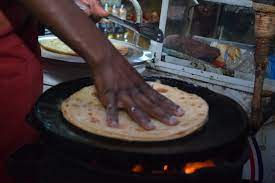By SALLY MUTEMBEI
Allow me to paint you a picture based in Kenya, in a place I like to call my city, my town, Nairobi. I was born and raised in Nairobi and I grew up for the most part hearing warnings from my mother not to eat any kind of street food. Her arguments were the same standpoints repeated over and over. Take for example; the food is dirty, the cooks don’t care for hygiene, the food is not fresh, that samosa isn’t actual meat you are eating, and whatever tall tale she could come up with to scare me from digesting the oh-so glorious delicacies. Just like any other playful child, I never listened.
My first ever street food was motura. Motura is a…think of it as a traditional Kenyan sausage. It’s made by stuffing goat intestines with seasoned ground meat. This was probably top of the list on my mother’s ‘do not eat’ list. Solely, for that reason, it was top of my ‘try it out’ list. My first time eating motura I was a teenager and it so happened that that night was the night I followed my sister out for a walk.
We talked about everything and anything under the sun, under the moon at that exact moment. Then came the part where we took a turn and ended up by the main road where that waft of smoke silenced my every thought. There it was, that marvellous sight of barbecued sausage.

My sister looked at me and noticed that I was staring in a specific direction when she asked a very magical question, “Unataka motura?” (Swahili for, “Do you want to eat motura?”) If my eyes didn’t say yes, my determination to cross the road to get to the food stand whilst pulling her hand was enough of a yes. She taught me the magical rule of how to order motura, especially if it’s a new place you are trying out; “Nipee ya mbao,” (Swahili for ordering a piece of the motura that is worth 20 Kenyan Shillings. ‘Mbao’ in this case means 20) I greedily stuffed the first piece in my mouth and I remember the explosion of the flavours inside my mouth.
My mind was blown by how I had never known of something that tasted so good. We proceeded to order one round after the other and before I knew it, I was already a motura fanatic. The last but most important rule she taught me that night is that after eating motura, we should buy some minty gum to clear our breath to avoid getting caught by our mother. What logic! What a night!
Fast forward to today when I’m now older and live by myself with no one to set any limitations for me (cue my mother’s endless but consistent speech of how one should never consume certain foods). I happen to have what one would call ‘adult money’ and believe me when I say “I know all the best spots to get some amazing motura”. That experience raised a curious child who wanted to explore food that was said to be off-limits. I also ended up learning to experiment with the food I cook and colouring my kitchen with different flavours.
One very popular street food is the chapati. Chapati is probably the king of accompaniment as it goes well with almost every kind of stew. I see the satisfaction on the faces of my fellow Kenyans when one just comes from buying chapatis from their favourite ‘kibanda’ (Kibanda is a Swahili word for an informal eatery). There is a sense of pride in knowing that you bought your chapati from a great place, especially if the chapati is a perfect marriage of crisp and soft.
Chapatis met Kenyans who are known to be very creative. One such case would be the emergence of the sale of ‘rolex’, no, not the watch. ‘Rolex’ is a combination of chapati and fried eggs sandwiched together. Or the “Chapo-smokie”, a combination of smoked sausages sliced in half put together with some salad and sauces rolled inside a chapati. So then I ask the question again, what comes to mind when you hear the words “street food”?



